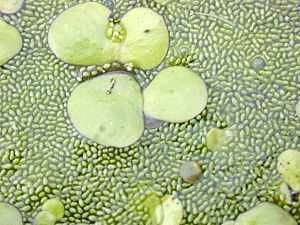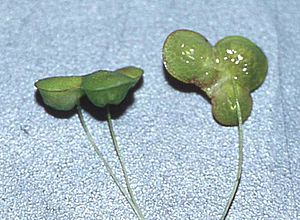Duckweed facts for kids
Quick facts for kids Duckweed |
|
|---|---|
 |
|
| Close-up of two different duckweeds : Spirodela polyrrhiza (larger) and Wolffia globosa, which are less than 2 mm long. | |
| Scientific classification |
|
| Kingdom: | Plantae |
| Clade: | Tracheophytes |
| Clade: | Angiosperms |
| Clade: | Monocots |
| Order: | Alismatales |
| Family: | Araceae |
| Subfamily: | Lemnoideae |
Duckweed, also known as water lens or bayroot, are tiny freshwater aquatic plants. You can find them floating on the surface of calm or slow-moving fresh water and in wetlands. There are about 33 to 38 different species of duckweed, grouped into five main types, called genera.
These plants are very simple. They don't have clear stems or leaves like most plants. Instead, each duckweed is a small, flat structure called a "thallus" or "frond." It's only a few cells thick. Often, these fronds have tiny air pockets that help them float on or just under the water. Some duckweeds have no roots, while others have one or more simple rootlets.
Duckweed usually makes copies of itself by asexual budding. This means new plants grow directly from the parent plant. Sometimes, they produce tiny flowers for sexual reproduction. These flowers are very small, with two stamens and a pistil. After this rare flowering, a seed forms inside an air bag that floats. The flower of the Wolffia duckweed is the smallest known flower in the world, measuring only 0.3 mm long!
Contents
Duckweed in Nature
Duckweeds need nutrients to grow well. They are often found in water that is rich in nutrients, sometimes even in places with too many nutrients (called eutrophic conditions). These tiny plants can spread easily. They stick to the feet and bodies of waterfowl (like ducks) and small mammals. Moving water can also carry them to new places.
In areas with strong currents, duckweeds don't grow as thickly. But in calm water, they can multiply very quickly. When rainy periods follow, the plants can be carried away by the increased water flow.
Duckweed is a great food source for waterfowl. It has more protein than soybeans! These tiny plants also provide shelter for many small water creatures. For example, bullfrogs and fish like bluegills hide among the duckweed.
Duckweed and Water Cleaning
Duckweeds are very good at cleaning water. They can help remove nitrates if they are harvested regularly. They are important in a process called bioremediation. This means they grow fast and soak up extra mineral nutrients, especially nitrogen and phosphates. Because of this, many people see duckweed as a valuable tool for purifying water.
Duckweed can also be used in wastewater treatment to capture harmful substances and control bad smells. If a thick layer of duckweed covers the water, it can stop algae from growing. It also helps control mosquitoes from breeding.
These plants can even help save water. A layer of duckweed on the surface reduces how much water evaporates into the air. This means less water is lost compared to a clear water surface.
Duckweed Research and Uses
Scientists are very interested in duckweed. In 2008, the U.S. Department of Energy (DOE) decided to study the genetic code (genome) of the giant duckweed, Spirodela polyrhiza. This research aimed to find new ways to create biomass and biofuel.
Duckweed is a good choice for making biofuel. It grows very quickly and can produce five to six times more starch than corn from the same amount of land. Also, using duckweed for fuel helps fight global warming. Unlike fossil fuels, duckweed takes carbon dioxide out of the air instead of adding it.
Duckweed also filters out harmful things like bacteria, nitrogen, and phosphates from natural water bodies, wetlands, and wastewater.
-
Common duckweed in Galicia, Spain
-
Water covered with duckweed, next to bald cypress trees.
Images for kids
See also
 In Spanish: Subfamilia de las lentejas de agua para niños
In Spanish: Subfamilia de las lentejas de agua para niños











